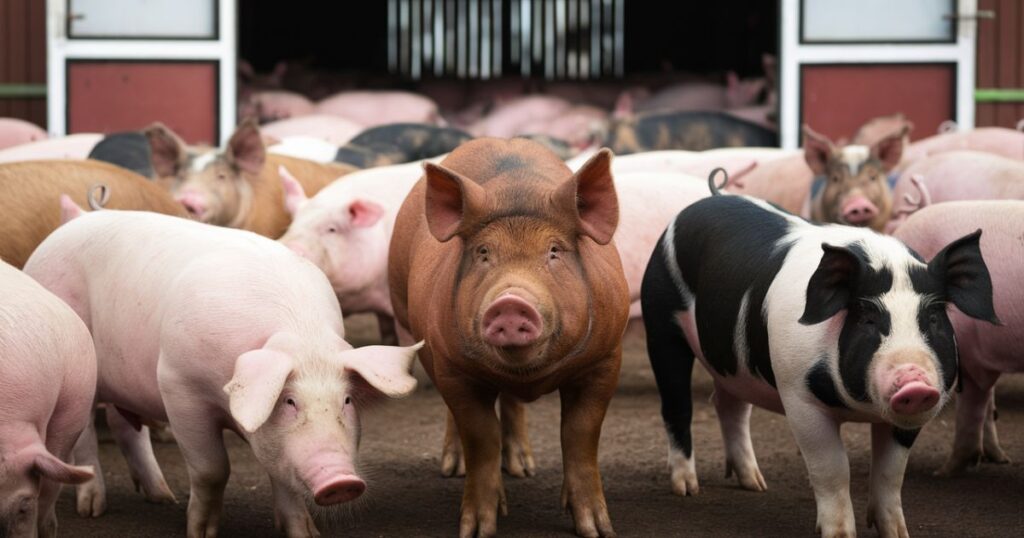Dreaming of raising your own pigs for succulent pork chops, flavorful bacon, and savory sausage? Having pigs on your homestead is immensely rewarding – you get to enjoy unbeatable freshness and know exactly what went into producing your food.
But with so many breeds to choose from, selecting the right one can feel overwhelming. The breed you raise will determine crucial factors like growth rate, litter size, meat quality, and overall productivity.
That’s why choosing the perfect pig breed for your farm’s needs is absolutely essential for a successful meat operation. This guide will walk you through the 10 most popular meat pig breeds raised today, highlighting their unique strengths to help you make an informed decision.
What breed of pigs are best for meat?
There’s no one-size-fits-all best when it comes to meat pig breeds. Each variety offers its own set of advantages and drawbacks. Some excel at rapid growth for market, others produce premium marbled meat, and certain breeds are praised for their unbeatable mothering abilities.
The breed that’s best for you depends on your specific goals and set-up. An urban homesteader with limited space may prioritize a smaller, low-maintenance breed.
A farmer selling premium pork cuts would want one adept at marbling. And a breeder would need prolific mothers with ample milk supply.
Choosing a Meat Pig Breed for Your Farm
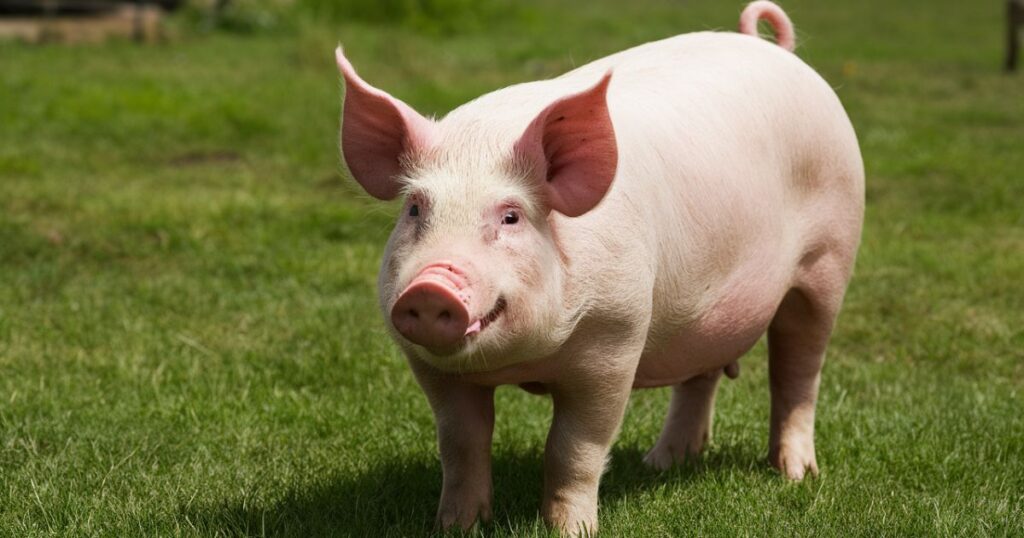
Before we dive into breed profiles, let’s cover some key factors to consider when choosing a meat pig breed:
Growth Rate & Size: How quickly the pigs reach market weight (faster = more efficient), as well as their overall size and slaughter weights.
Litter Size: Number of piglets in each farrow (more = higher output). Larger litters require excellent mothering ability.
Mothering Ability: A sow’s maternal instincts including milk production, building sufficient nests, and avoiding crushing piglets.
Meat Quality: Taste, tenderness, fat-to-lean ratio, and marbling in the meat. This impacts premium pricing potential.
Hardiness & Survivability: Some breeds tolerate hot/cold better and are less prone to disease or defects like Porcine Stress Syndrome (PSS).
Feed Efficiency: How well the breed converts feed into muscle versus fat, reducing feed costs.
Docility: Good-natured, calm temperaments make handling, transportation, and even kids showing the pigs safer.
Purpose: Are you raising just for your family’s meat supply? Breeding/selling piglets or pork products? Show/competition pigs? Market preferences vary.
Grab this FREE Livestock Planning Guide for a total roadmap to raising animals for fresh meat, eggs, and dairy.
Read More :
Should I Get A Pet Raccoon? The Surprising Reality
Identifying Meat Pig Breeds
Before getting into breed specifics, here’s a handy tip for easily identifying pig breeds: If the name ends in -shire, it refers to a breed with erect, upright ears. Breeds like Yorkshire, Berkshire, Hampshire, etc.
Floppy or drooped ears indicate breeds like Duroc, Landrace, Meishan among others. Color patterns are also identifiers – for instance, the Berkshire is the only breed with distinct white points on its black body.
Pro Tip: When evaluating potential breeding stock or new additions, take lots of photos! Having visual references makes it much easier to compare traits like ear carriage, color markings, body length, etc. between animals.
10 Most Common Meat Pig Breeds
Now let’s meet the star players and explore what makes each breed excel (or fall short) for meat production:
1. Yorkshire
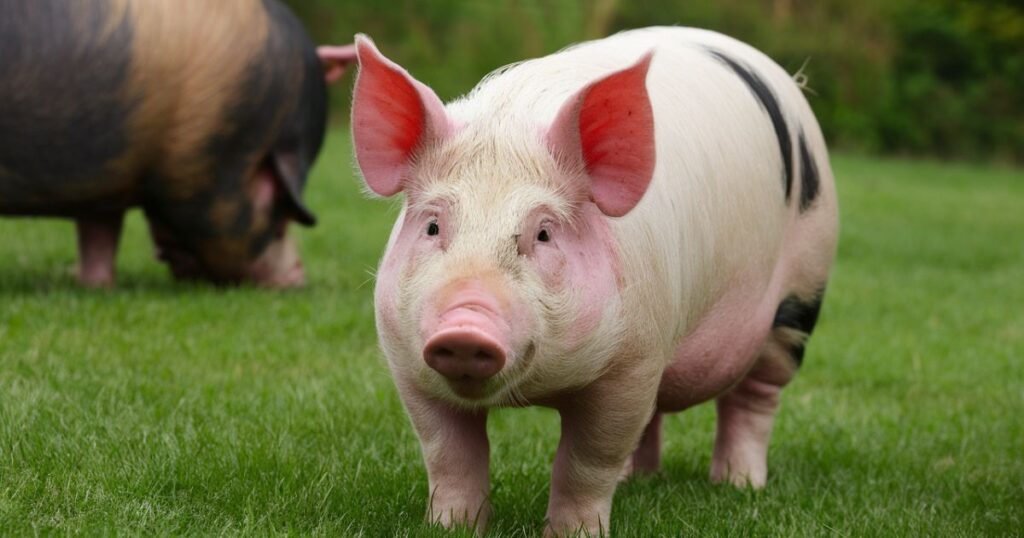
The prolific Yorkshire is the #1 most popular breed in North America. Solid white from their erect ears to pink skin, these pigs clock in as:
- Large & Rapidly-Growing: Putting on weight efficiently to reach market weights faster
- Excellent Mothers: Yorkshire sows are known for producing large litters (12+ piglets) and ample milk supply to raise them
- Long-Lived Productivity: With their heartiness, Yorkshires stay productive for years after reaching maturity
On the downside, their light skin makes Yorkshires highly susceptible to sunburn – they require shade access. Their white hair is preferred by processors though as it doesn’t show on the carcass like darker breeds.
The Mother Breed and a Whole Hog More is a fitting motto for this prolific, fast-growing variety. If you want heavy litters coupled with rapid meat production, Yorkshires could be your pick.
PURPOSE: Top choice for consistent, high-volume meat production for family or sales. Great for crossbreeding too.
2. Duroc
With their floppy ears and distinctive red coloring, Durocs stand out as the second-most raised breed in North America for good reason:
Pros:
- Medium to Large Size: Ample meat yield in a robust, muscular frame
- Lean & Muscular: Gains are dense muscle rather than just fat
- Longevity & Cold-Hardiness: Cold weather and winter-proof thanks to their thick skin/coat
- Docile Temperaments: Their pleasant dispositions make even youngsters feel safe showing Durocs
Potential Cons:
- Less Prolific: While fertile, their litters run smaller than other breeds
- Adequate Mothers: Not as exceptional at raising large litters as Yorkshire or Landrace dams
Our resident sow Bacon is a Duroc and she’s been an absolute gem. Over the years she’s effortlessly raised multiple litters of up to 15 vigorous, beefy piglets. And her calm, friendly temperament means my kids can be around her without worry.
PURPOSE: This versatile breed balances plentiful lean meat with hardiness for outdoor rearing. Their quality pork and easy handling make them fantastic all-around homestead pigs.
3. Berkshire
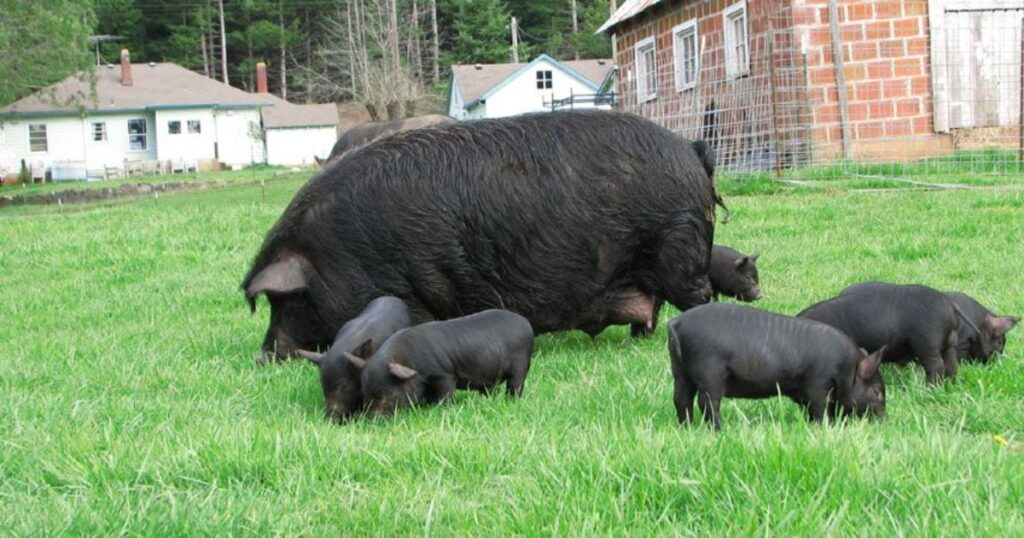
The Kobe Beef of Pork! If you’re after unbeatable flavor and luxuriously marbled meat, you can’t beat the iconic Berkshire breed. These black-bodied pigs with white points produce what’s prized overseas as Kurobuta or Black Pork.
What Makes Berkshire Meat So Luscious?
- Superior Marbling: Intramuscular fat yields incredibly tender, rich, full-flavored pork
- Darker, Redder Meat Color: Indicating higher pH for elevated tenderness
- Bold Taste: More intense porky flavor compared to leaner commercial pork
Everyone knows some of the best steaks come from well-marbled Angus cattle, says one Berkshire breeder. That’s the magic Berkshires bring to the pork world.
While their meat commands premium pricing, Berkshires are merely decent in other areas like:
- Feed Efficiency: So-so at converting feed to lean muscle gains
- Litter Size: Average of 6-8 piglets, not exceptional
- Growth Rate: Moderate, take longer than leaner breeds to finish
But for pork connoisseurs who want to enjoy butchery-level quality from their own pigs, the incomparable taste of Berkshire meat is well worth it!
PURPOSE: Homestead operations focused on producing & selling delicacy-grade specialty pork cuts, charcuterie, etc. Incredible eating quality for the family too.
4. Landrace
Thanks to their distinctive long, solid white bodies and floppy ears, Landrace hogs are hard to miss. This breed originated to create more surface area for maximum meat yield from each ham:
Key Landrace Traits:
- Long, Lean Bodies: More streaky bacon & larger pork loins per animal
- Muscular & Lean: Focus on muscle over fat produces lean pork cuts
- Large Litters: Highly prolific birth rates up to 14 piglets
- Excellent Milk Supply: Plenty of nutrition for big litters
Our current Landrace gilt ‘Lucille’ really shows off the pig breed’s racehorse-like silhouette, notes one farmer. She’s much leaner and longer than our other pigs.
While great for maximizing meat production, Landrace’s pale skin makes them extremely prone to sunburn – ample shelter is a must. Their less robust builds can sometimes struggle in cold or variable climates too.
5. Meishan
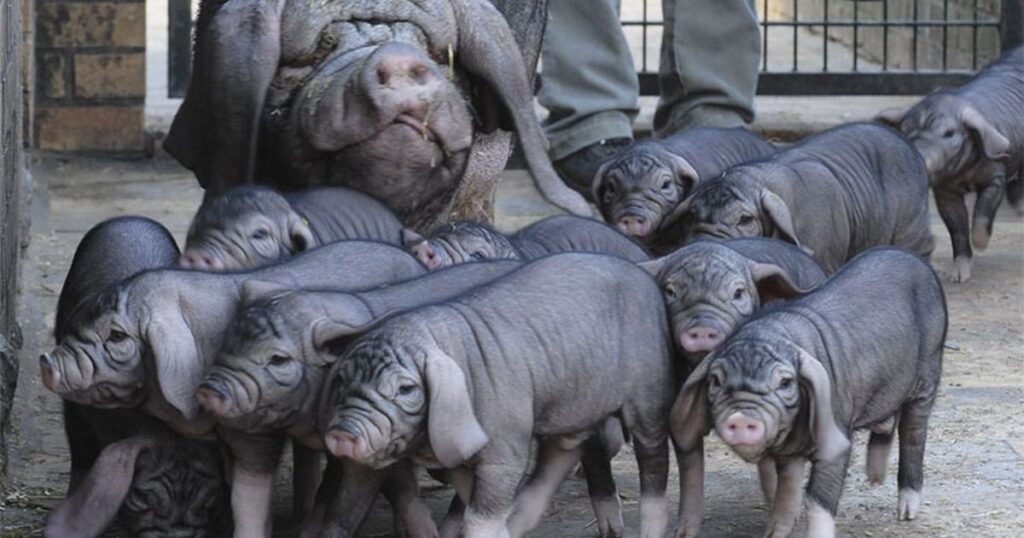
The Meishan may not be a household name, but this unique Chinese breed deserves a look for small homesteads or farms focused on breeding stock. Though smaller-framed than conventional pork pigs, Meishans offer:
Prolific Birthing:
- Reach puberty as young as 3 months old
- Produce unusually large litters of 15-20 piglets
- Known for their exceptional fertility rates
Premium Meat Quality:
- Higher fat and marbling for rich, flavorful pork
- Though high in fat, meat is still quite tender
- Almost a wild pork flavor compared to modern pigs
Hardy & Low-Maintenance:
- Thrifty foragers that thrive in outdoor/pasture set-ups
- Adapted to get by with basic shelters and feed rations
- Less likely to sunburn thanks to their darker skin/coat
The trade-off? Meishans grow slower and stay smaller — think pot-bellied pig body type. But their unique flavor and maximum productivity per litter make them assets for homesteaders prioritizing breeding stock over slaughter weights.
PURPOSE: Specialty meat production, breeding stock to improve litter sizes
6. Chester White
Clad in immaculate white with that signature droopy-eared look, the Chester White has been an American farmstead favorite for generations. These pigs are beloved for their:
Unbeatable Mothering Instincts:
- Attentive dams with ample milk supply
- Can rear larger litters all the way to weaning (12+ piglets)
- Often used to pass this maternal ability to crossbred offspring
Hardy, Productive Dispositions:
- Thrifty foragers that maintain good body condition
- Longevity and ongoing productivity year after year
- Adaptable to various environments and housing setups
Our Chester White boar ‘Kody’ is a retired show hog, says one owner. Despite being over 600 pounds, he’s docile enough for our kids to be around – even with his piglets!
While not bred specifically for maximum lean meat, their ample muscling produces respectable yields of quality pork. The main drawback is their fair skin requiring shelter from sunburn.
PURPOSE: General homestead breed, sows for breeding/crossing, extended productivity
7. Hampshire
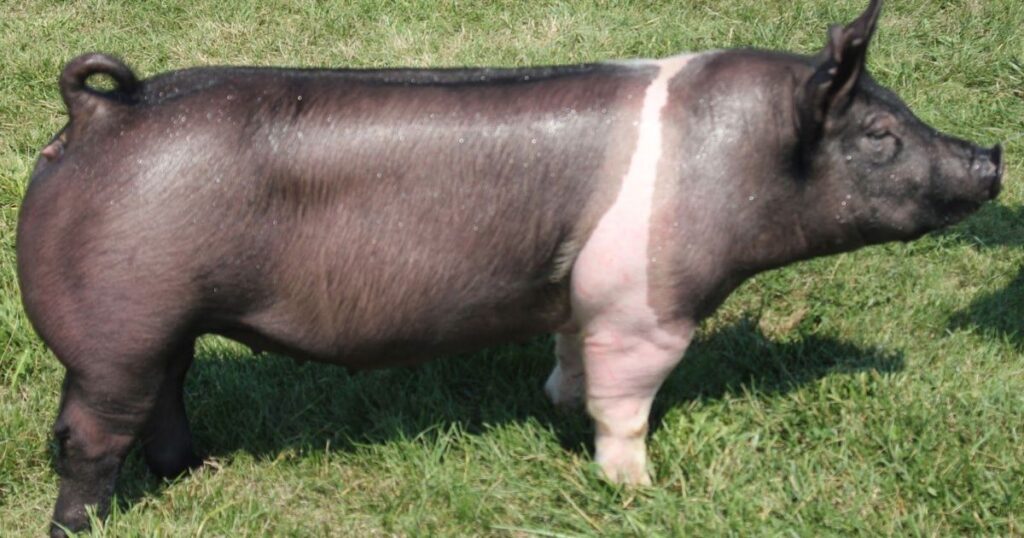
Distinctive for their thick belts of white wrapping their black bodies, Hampshire hogs are truly a sight to behold. This unique striped pattern indicates more than just looks though:
Lean Meat Machines:
- Extremely muscular with dense, high-quality lean pork
- Efficient feed-to-gain ratios produce maximum leanness
- Coupled with ample dressing percentages for high carcass yields
Potential PSS Carriers:
- Can carry the Porcine Stress Syndrome gene
- Causing poor meat quality/defects if inherited
- Reputable breeders carefully test to avoid affected pigs
Other Traits:
- Decent growth rates and mature size for market hogs
- Fairly large litters from attentive sows
- Docile dispositions suitable for youth showmanship
So while Hampshire are stellar terminal meat sires, their PSS risk means careful management. Purchasing boars or semen from PSS-negative, stress-free lines is vital.
PURPOSE: Lean meat production, terminal sires to avoid PSS, junior show prospects
8. Pietrain
[Pietrain Pig Photo]
With their unique black patches on white coats, Pietrain pigs (nicknamed Spots or Pie Trains) really stand out in a crowd! But their distinct appearance matches their distinct qualities:
Extreme Leanness & Muscularity:
- Among the leanest pork available, very little fat
- Impressive feed conversion into muscle and mass
- High dressing percentages for maximum carcass yield
Fast, Efficient Growth Rates:
- Ability to reach market weights sooner reduces finishing costs
- Earlier slaughter means quicker pay-off and turnaround
But a Catch…Porcine Stress Syndrome Risk!
- Like Hampshires, Pietrains are known PSS gene carriers
- Strict genetic testing and linebreeding is crucial
- Never breed Pietrain to Pietrain without clearing PSS status
When sourced responsibly from reputable PSS-negative stock, Pietrain boars can be phenomenal terminal sires. Their leanness is unmatched for producing low-fat, high-protein cuts of pork and processed meats.
PURPOSE: Terminal sire for low-fat pork operations, processed meat production
9. Hereford
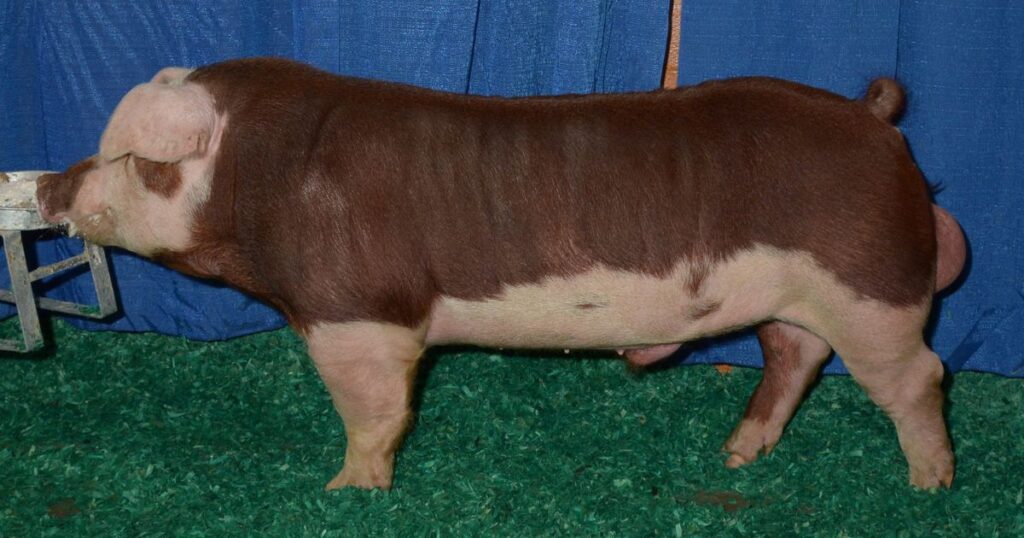
Named for their iconic red bodies and white markings mirroring Hereford cattle, these spunky pigs have risen in popularity — especially among small farmers and homesteaders. Why?
Perfect for Pasture-Raising:
- Excellent foraging skills to thrive on a diet of greens/roots
- Able to effectively build body condition and finish on pasture
- Don’t require as much supplemental grain feeding
Good Maternal Traits:
- Respectable litter sizes of 8-12 piglets
- Known for being attentive, productive mothers
Respectable Meat Quality:
- While not as lean as modern terminal breeds
- Hereford pork maintains ample marbling for tenderness
- Richer, more old-fashioned flavor profile
Other Pros:
- Hardier versus sunburn than fair white breeds
- Good-natured temperaments make them easier to handle
- Thrifty and low-maintenance compared to industrial pigs
For homesteaders wanting maximum self-sufficiency, Herefords offer old-school pork production right on the land with less reliance on feed inputs and confinement.
PURPOSE: Homestead meat pigs, sow productivity, pasture-based rearing
10. Tamworth
Resembling their wild boar ancestors more than modern pigs, Tamworth hogs stand out with their golden-red bristles, razor-straight snouts, and ears erect with an alert presence. More than just their looks though, this heritage breed excels as:
Exceptional Foraging Machines:
- Scavenging skills to thrive with minimal inputs or interference
- Able to glean most of their nutrients from rootings and forage
- Requiring only basic shelter and supplemental feed
Excellent Mothers for the Breed:
- Known for vigilant maternal behavior and plentiful milk
- Routinely wean large litters of vigorous piglets annually
- Patience tends to pay off for maximal litter retention
Niche Specialty Meat Products:
- Can be crossed with wild boars for wild-hog-like products
- Distinct flavor that stands out from commercial pork
- Preferred by some ethnic communities over standardized pork
While their compact size and slower growth wouldn’t suit commercial operations, Tamworths hit all the marks for sustainable homestead systems:
- Minimum housing/feeding requirements
- Premium meat with memorable taste
- Lots of support from niche breeding groups
For environmental and culinary enthusiasts raising homestead meats, the hardy, prolific Tamworth could be your breed!
PURPOSE: Sustainable homestead meat operations, heritage pork production
What are you looking for?
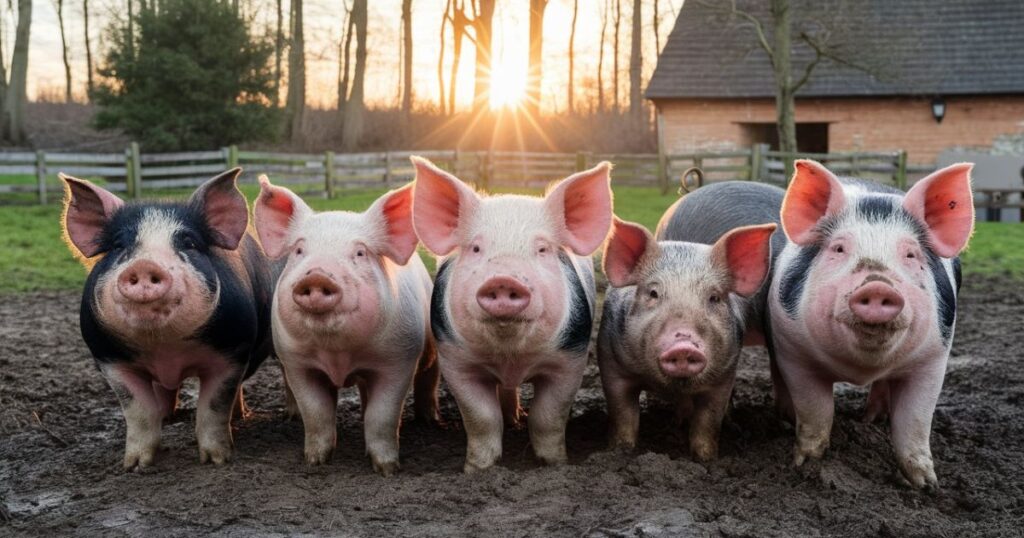
With so many standout meat pig breeds to choose from, it can feel overwhelming trying to pick! To simplify your decision:
First, estimate how much pork your family consumes and in what forms – like bacon, sausages, chops, hams etc. If you go through a ton of ground pork or use lots of pork fat for sausage/charcuterie, a lard-type breed like Berkshire may be preferable over ultra-lean Pietrain.
Next, consider if maximizing litter size or mothering ability is a priority. If so, prolific breeders like Meishan, Landrace, and Chester Whites may top your list. But if you only need a few modest litters annually, minor differences in prolificy won’t matter as much.
Finally, production goals are key. Are you solely raising pork for your family’s consumption? Pursuing breeding stock sales or direct marketing meat? Or fitting specific show ring criteria? Let your main purpose be your guiding light.
Why Will You Be Raising Pigs?
Clearly defining your primary purpose for raising pigs will help immensely in narrowing down an ideal breed. Here are some common motivations to consider:
Feeding Your Family If your sole aim is producing pork for your household’s consumption, Choose breeds well-suited to your environment that yield quality meat, grow efficiently, and have good overall hardiness. Having ample mothers isn’t as critical versus breeds geared for maximum meat output.
Breeding/Sales Prioritize prolific breeders like Landrace, Meishan, and Chester Whites. Sows with exceptional maternal traits and large litters will maximize your breeding stock output and sales.
Show Animals Research what breeds are popular, winning, and preferred in your local show circuits. Secure show-quality breeding lines and seedstock that excel in areas judges evaluate: muscling, body structure, frame size, etc.
Direct Marketing Meat For selling premium pork cuts or value-added meat products, focus on breeds prized for superior meat quality above all. Berkshire and heritage breeds like Tamworth may command higher prices from discerning customers. But leaner, higher-yielding breeds could suit selling affordable staples like chops, hams, etc.
No matter your main purpose, it’s wise to explore the breed trends and buyer preferences in your local markets before investing heavily in any one variety. Attend shows, talk to successful breeders, and even visit processors to get the inside scoop.
And don’t forget the power of visuals! Take photos of any promising prospective breeding stock to compare traits side-by-side before deciding.
So many meat pig breeds, now what?
By now you should have a solid grasp on the strengths, weaknesses, and ideal production scenarios for many popular meat pig breeds. But how do you ultimately settle on the right one(s) for your farm?
My advice: Make two lists – one of your top priorities for meat production, and another of your operational capabilities and constraints.
Priorities could include: Maximum leanness, superior marbling, fast growth, large litters, hardy foraging abilities, specific carcass characteristics, etc. Get very clear on your biggest must-haves.
Then outline your farm’s realities – available housing, shelter, and rearing environments, feed resources, labor capacity for maintenance, financial limitations, processing options, and any weather considerations.
With priorities and practicalities side-by-side, you can start eliminating breeds that just won’t be a good fit. From there, it becomes easier to choose one or two that comprehensively check all the essential boxes.
Don’t feel limited to raising just a single pure breed either! Crossbreeding multiple varieties can strategically combine their strongest traits into an ideal hybrid vigor for your operation. Maybe you cross prolific Meishan sows with muscular Terminal sires.
FAQs
Which pigs are best for meat?
There is no one “best” pig for meat – different breeds offer advantages in growth rate, meat quality, litter size, etc. Popular choices include Yorkshire, Duroc, Berkshire, and Landrace.
What breed of pig is used for commercial meat?
The Yorkshire is the most widely used commercial breed, prized for rapid growth, productivity and yielding heavy muscled carcasses. Durable breeds like Duroc are also commercially popular.
Which pig breed grows fastest?
Some of the fastest growing breeds include Yorkshire, Landrace, and Pietrain. Their ability to efficiently convert feed to lean muscle mass allows them to reach market weights sooner.
What are the three 3 types of pig?
The three main types are: 1) Lard pigs raised for fatty meat products like sausages (e.g. Berkshire) 2) Bacon pigs with long bodies for increased belly meat (e.g. Landrace) 3) Meat/Sausage pigs raised for lean muscle and hams (e.g. Yorkshire, Duroc).

